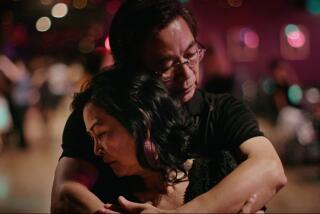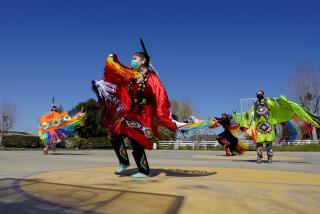Dance Troupe Tours Mideast : American Indians Fascinate Bahrainis
- Share via
MANAMA, Bahrain — War whoops pierced the desert stillness. Tom-toms kept the beat as dancers circled under the starry sky and the campfire cast their shadows onto adobe walls.
The American Indian had come to Arabia.
The fascinated onlookers were Bahrainis, who also have tribal origins but dance to different drums.
The occasion was a cross-cultural pow-wow and the visitors were members of the American Indian Dance Theatre, a troupe of 15 on a tour of the Middle East and Europe sponsored by the U. S. Information Service.
The Americans, representing eight tribes from Apache to Zuni, said they were delighted by the Arabs’ enthusiastic response to their performances of traditional dances in authentic dress.
“We show them the vibrant colors, our beadwork, the songs, dances. In a sense, they’re just like us, they have their tribal songs and dances that are new to us, just as ours are to them,” said Marty Pennecoose, 31, a Southern Ute who lives in Salem, Ore., and works in construction.
The desert gathering, arranged by the U. S. Embassy, was a private affair in the ruins of an 80-year-old sheik’s palace, within sight and smell of Bahrain’s oil and gas fields.
The 50 or so American guests sat on rugs in the sand, eating roast lamb and other Middle Eastern foods, to watch an all-male Bahraini dance group perform.
The Indians later staged an impromptu performance. Long hair and braids flew as the dancers, in jeans and cowboy boots or sneakers instead of tribal costumes, mingled with the Bahrainis in their white robes and Arab headdresses.
Pennecoose said it was “a learning process, going to these different countries, experiencing their surroundings and cultures, things that we’d only see in books.
“We want to show the rest of the world what we have to offer,” he said. “It’s a good thing, what we’re doing, dancing around the world.”
Arlie Neskahi, 32, a Navajo and lead singer, said he found cultural similarities as well as differences.
“Our people are shepherds and I grew up eating lamb and goat,” said Neskahi, who wore an Arab head scarf wrapped in the style of Yemen, one of the group’s earlier stops.
“My father always told me it takes all the colors of the rainbow to make it beautiful,” he said.
“We want to share our cultures with other people who don’t know anything about us,” said Chester Mahooty, 60, a Zuni from New Mexico who is the troupe’s senior member.
“The people here think that John Wayne is the most popular, not the Indians. We have to tell them the truth.”
It was that stereotype that the company’s founder and producer, Barbara Schwei, said she wanted to dispel.
“I felt there was definitely a need to express the American Indian culture . . . because there is such a lack of information. I thought it was time for a company done properly, playing first-class theaters all over the world.” Schwei, with director and choreographer Hanay Geiogamah, recruited the dancers during visits to Indian pow-wows and festivals in the Southwest and northwestern United States.
The members are drawn from both American and Canadian tribes.
Geiogamah, a Kiowa Delaware from Oklahoma, said the result is “a kind of new pan-tribal idiom” that helps Indians preserve and expand an important art form.
Mahooty, who adorns himself with huge, turquoise-studded breast plates and rings, said American Indian dances emphasize a religious relationship with nature.
Many are acted-out prayers to the “Great Creator,” Mother Earth, or mountain spirits, for rain, good harvest or hunting. “Eagle dances,” common from the northern plains to the southwestern pueblos, pay homage to the soaring bird that Indians believe has direct contact with deities in the sky.
One Bahraini spectator said the Indians’ visit gave him a new look at a people “we know only from cowboy films.”
More to Read
Sign up for The Wild
We’ll help you find the best places to hike, bike and run, as well as the perfect silent spots for meditation and yoga.
You may occasionally receive promotional content from the Los Angeles Times.





